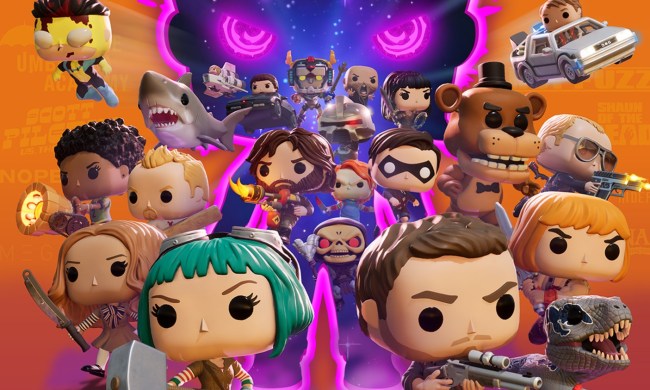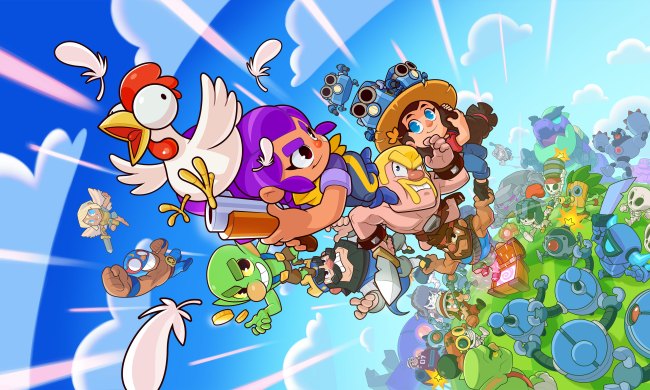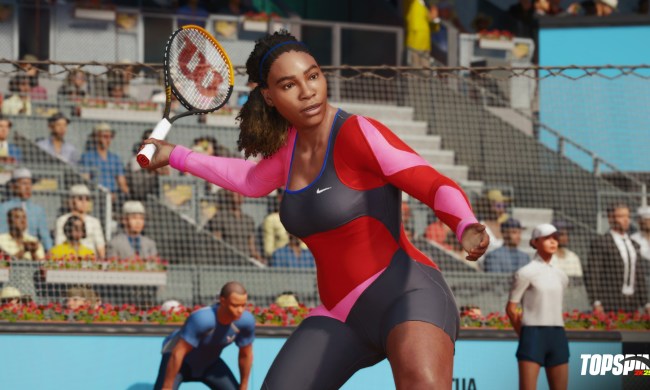Battleborn is definitively not Borderlands. After spending some time gawking at an early build of the 2015 game from Gearbox Software, this much is already clear. Part RPG-inflected shooter (not Borderlands), part multiplayer online battle arena (but don’t call it that), Battleborn is described by Gearbox as a “hero-shooter.”
Really though, at this point? They’re just words. This is a game from a team that is known for its ability to wrap deep character progression systems around the satisfying immediacy of first-person shooter play. More than that, they do it with style. There’s a lot going on beneath the surface of Battleborn that we just haven’t seen yet, but 2K’s recent first look paints enough of a compelling picture to pique our interest.
Story/Concept
When all the lights go out. Battleborn is set in a universe in which all the stars in the sky have darkened, save one: Solus. After the lights went out, those species that were capable of interstellar flight converged on the last remaining source of light, heat, and energy, and a new, diverse community was formed, albeit one split along factional lines and rife with disputes over the solar system’s limited resources.

Unfortunately for the surviving races of the galaxy, there’s a greater threat lurking in the vast shadows of the starless sky. A race of invaders known as the Varelsi is responsible for snuffing out all the celestial bodies, and they’ve turned their attention to Solus. In response, the five factions set their differences aside and raise up an order of heroes to fight against the menace. These heroes are known as the “battleborn.”
Mash-up. Battleborn seems like a true-blue mash-up. There’s a five-player cooperative campaign and a competitive five-versus-five multiplayer mode. There’s a cast of playable characters that draws from sources as diverse as alien warfare sci-fi, wizards & warriors, high fantasy, steampunk, feudal Japan, and more. You max out your ability leveling in the space of a single match or mission, but there are also more long-term hooks that we’re told compare to the Badass Ranks of Borderlands 2.
Just look at the rundown of Battleborn‘s five factions:
- Jennerit — This is a conqueror civilization that values power above all. Rath, one of the first characters introduced from the Jennerit faction, is a melee-only fighter that walks around with a samurai sword strapped to his back.
- Peacekeepers — Carrying the biggest gun is the surest route to peace. That might not be an official motto for the Peacekeepers, but it certainly seems to define the rah rah military attitude of Peacekeeper characters like Montana, a mountain of a man who mows down the opposition with his mountain of a minigun.
- Rogue — Less a faction than a loose assemblage of rogues, pirates, and traders, Rogues are the swashbucklers of the Battleborn universe. Witness Reyna, who combines a pistol with gadgets like her high-tech glove.
- Eldrid — The Eldrid hail from a magical realm where things like elves and magic are an everyday reality. Enter Miko, a sentient mushroom with a knack for botany, magic, and flinging pointy knives at hated enemies.
- LLC — Short for Last Light Consortium, the LLC are war profiteers, simple as that. Marquis, a former robot butler that went nuts and developed a homicidal streak, is as debonair as he is deadly, using his cane/sniper rifle and Derringer-style pistol to fend off invading aliens and gross poor people.
As you can see from the five factions, there’s a mixture of fictions at play here. Even Battleborn‘s art style complements this melding of different ideas and fictions, a blend of 2D and 3D graphics that are as reminiscent of Borderlands as they are unique.
Gameplay
Save the galaxy. The five-player cooperative campaign side of Battleborn sees our heroes taking the fight to the Varelsi. In the lone mission we saw during our demo — an eyes-on-only affair — the battleborn pay a visit to the planet Tempest in search of valuable shards. The narrative particulars surrounding all of this remain murky, so let’s look at the mission design instead.

Tempest is a planet of towering, angular spires connected in the skies by narrow walkways and jump pads that launch players between platforms. These very constrained pathways for moving from one location to the next provide the foundation for corridor-style gunfights.
The demo’s major encounter played out on a larger, more open platform, with the battleborn defending a location against waves of robot enemies while a found shard was beamed aboard their support ship. It’s possible to create fixed emplacements like turrets at nodes scattered around the combat area, but exactly how that feature works isn’t clear. Overall, the combat resembles what you’d probably expect from a Gearbox-crafted FPS.
Fight for glory (and loot). In addition to the campaign, Battleborn also features 5-versus-5 competitive play in a number of different modes. It’s designed with the intention of being very eSports friendly, with asymmetrically balanced characters duking it out in small arenas.

The lone match type we got to see is called Incursion. It’s an objective-based mode in which each team of five fights to tackle different objectives spread across the map. Taking a page from Titanfall, the map is populated by a mix of human-controlled players and lesser AI-controlled grunts. It all boils down to base defense; keep the other team out of yours while attempting to take control of theirs.
Twist! If all of this sounds fairly vanilla, that’s understandable. Five-player co-op in the campaign is a twist on the usual four, but wave-based defense and objective-driven competitions are familiar ground for most modern gamers. It’s Battleborn‘s character roster and unique approach to progression that sets the game apart, from what we’ve seen.
Here’s where the influence of multiplayer online battle arenas (MOBAs) like League of Legends comes in. Each character has his or her (or its) own skill tree, and level advancement is paced so that every player can max out their tree during a given match. In Borderlands, you invested tens of hours into one character before hitting the level cap; Battleborn simply quickens that process.

Skills unlock at a rate of one per level earned, and each new level always presents the unlocks as a binary choice visualized on a DNA-like helix. Each character seems to play very, very differently, and we’re told that skill tree unlocks fall more into the realm of new or altered abilities than they do simple stat boosts. The reasoning is: If you’re going from zero to max level in the space of a 30-minute match, each unlock choice you make should have a meaningful impact on how you play.
Separate from the in-match progression are two deeper systems — one for each character and one that affects every character associated with an individual player’s profile — but Gearbox isn’t sharing anything on these yet. The profile-wide progression compares to the micro-sized stat bonuses offered by Badass Ranks, as we already mentioned, but it’s not clear how the system works beyond that.
Presentation
Eye candy. At this early point in Battleborn‘s life, it’s the visuals that do the best job of selling the game. There’s an easy comparison to make with Borderlands, since both games share similarly comic book-style sensibilities, but that comparison falls apart immediately in a side-by-side comparison.

Where Borderlands’ dusty alien world of Pandora is all grit and rough edges, there’s a smoothness to Battleborn. The color palette is much more vibrant than Gearbox’s earlier effort. If Borderlands is a comic, Battleborn is more of a cartoon. This is especially apparent in the way the game mixes 3D characters and environments with 2D visual effects. The sight of a 2D mushroom cloud explosion against the game’s busy 3D backdrops is immediately eye-catching, and it helps to establish what amounts to a unique visual identity for the game.
Takeaway
Battleborn sits in a weird place right now. On one hand, it’s a Gearbox-crafted shooter that looks beautiful and features a diverse mix of influences, in terms of both the content and the design. On the other … well … we’re really not sure what the heck this game is. We’re looking forward to finding out more though.
Battleborn comes to PC, PlayStation 4, and Xbox One sometime in 2015.







